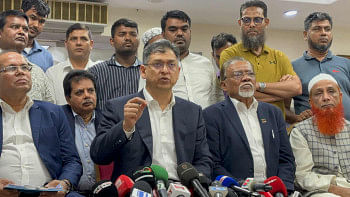Lessons From Aila
FOR the residents of the south-western coast of Bangladesh, John Donne's immortal sermon has become a way of life: never send for whom the bell tolls. It tolls for thee.
With every disaster come a new batch of hardened, jaded survivors who have not only lost faith in the mercy and sense of justice of the higher powers, but also in the general populace's will to help them out of their plight. They even give up trying to wonder how many of them will survive to see the next disaster and whether we'll be able to save them the next time.
"Amader kotha ki shobai bhule gese?" is a question that resounds in every disaster affected area within months after a disaster of the event. After days of talking about the victims, within weeks we forget about the survivors. There are needs and responsibilities that transcend the immediate relief and rescue efforts the need for recovery, sustenance and survival, and our responsibility to help build capacities of the survivors and of future generations because the next disaster is never too far.
The trail of devastation left by Cyclone Aila is still quite visible in most parts of Shyamnagar and Ashashuni upazillas of Satkhira, and, Koyra and Dacope upazillas of Khulna. Even months after the cyclone, the affected families are trying to rebuild their lives against the onslaught of a continuing fresh water crisis and the recurring collapse of the damaged river embankments. Schools are still closed as buildings are being repaired or rebuilt, and books and study materials are being replaced. Children are still dependent on humanitarian aid for their basic needs of food, safe drinking water, medicine and most importantly a safe shelter.
Children are the most vulnerable after a disaster because it changes the very realm of their living environment and destroys their comfort zones. They are unable to get regular meals, they stop going to school, and in most cases they end up sleeping under the open sky or in make shift houses which pose a serious threat to their security.
Diarrhea is one of the most common causes of child deaths during and after disasters, even though it is easily preventable. Malnutrition and discontinued breastfeeding are other threats to children's lives during emergencies, both of which can be easily addressed through interventions such as continued breastfeeding and low-cost, highly nutritious food supplements.
Hence, immediately after an emergency, there is a need to establish at least one safe area in a community where children can come to just be children. They can come to play, study and retain some semblance of normalcy in their upturned lives as they recover from the disaster. Lactating mothers are also able to use such spaces to breastfeed their children with some peace and privacy.
Immediately after Cyclone Aila, Save the Children set up 145 such safe places that provided support to 314 lactating mothers and protected over 7 000 children daily. But there still remains a need to scale up these efforts on a national scale. The safety and security of children during emergencies need to be addressed on a national scale.
For the full version of this article please read this month's Forum, available free with The Daily Star on October 5.

 For all latest news, follow The Daily Star's Google News channel.
For all latest news, follow The Daily Star's Google News channel. 



Comments